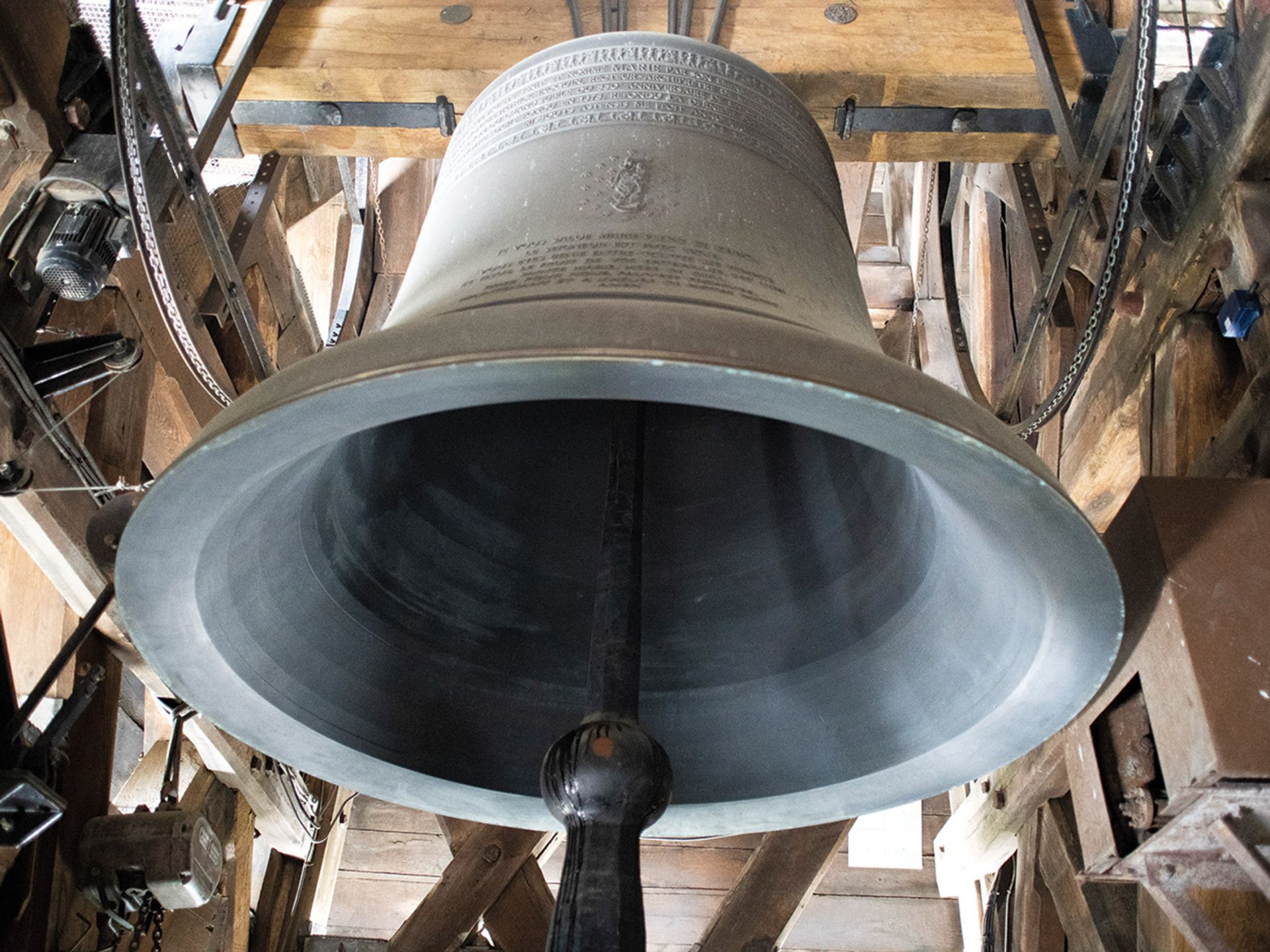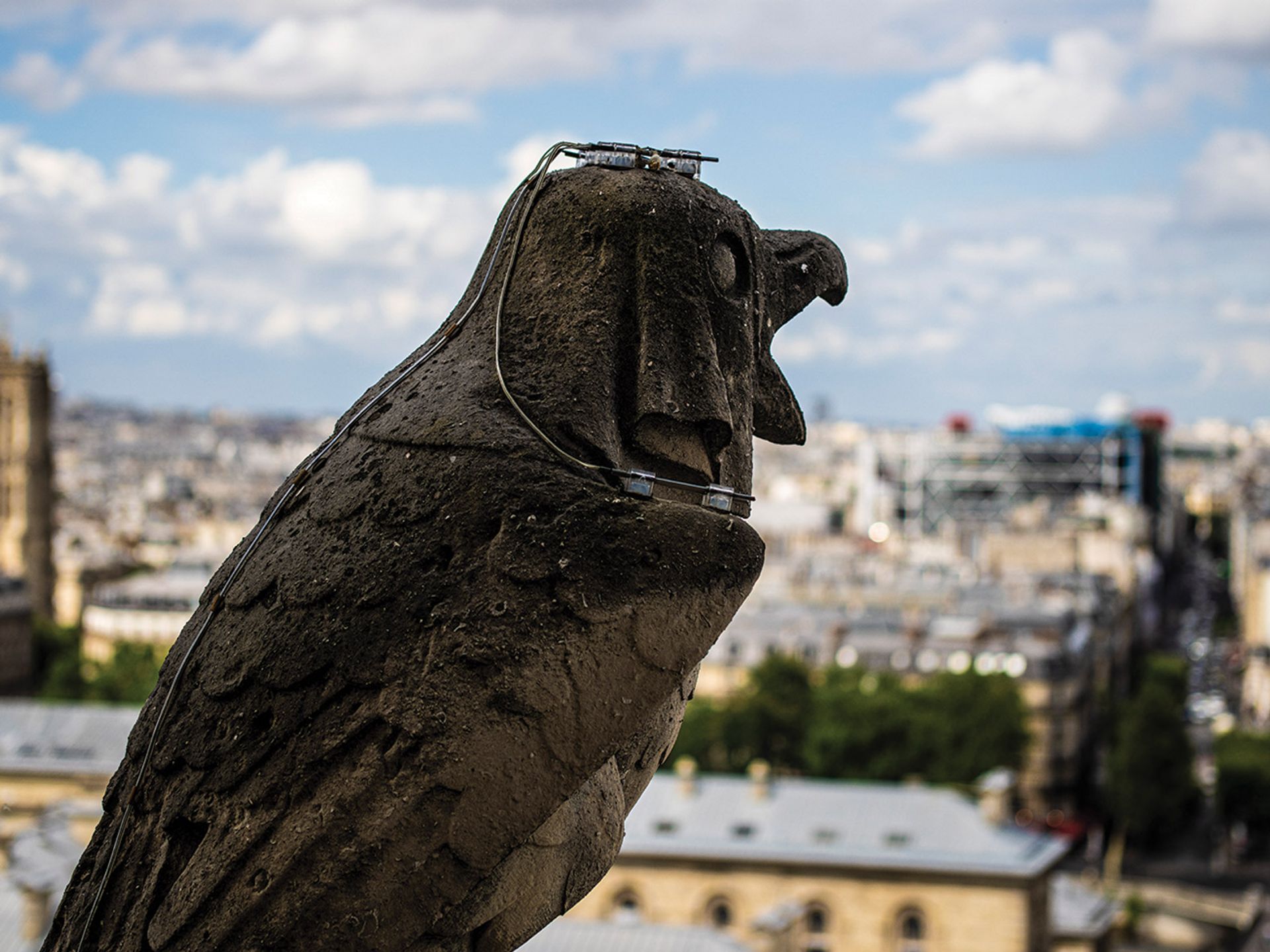Two years after a fire destroyed the roof and spire of Notre Dame in Paris, largely silencing the once active cathedral, a contemporary art project could help the historic site regain its voice as part of its reconstruction. The Bay Area artist Bill Fontana is currently working to record the sounds that the medieval church “hears” through its ten monumental bells, with plans to livestream the audio at the Institut de Recherche et Coordination Acoustique/Musique (Ircam) in Paris next year, and hopefully at museums and cultural sites around the world in the future.
“It’s a physical fact that these bells are actually vibrating all the time, it’s like a spirit that’s living inside of Notre Dame. It’s not dead, it’s alive,” Fontana tells The Art Newspaper in an exclusive interview. “When I had the opportunity [in July] to climb around in the bell towers, and actually physically access [the oldest and largest bell, named Emmanuel], and put my sensors on it to listen to what’s going on inside of it, I realised I was hearing a sound that probably nobody’s ever heard before that this bell is making and has been making continuously since 1681 [when it was recast]. It’s the voice, soul, the breath of the bell.”

The Emmanuel bell is said to be the most harmonically beautiful in Europe Courtesy of Bill Fontana
The artist has been working closely with Ircam, which is linked to the Centre Pompidou, along with a task force of researchers supported by the Ministry of Culture and Centre National de la Recherche Scientifique, which is studying the acoustic history of Notre Dame as part of the restoration process, and with the acoustic cultural heritage project The Past Has Ears at Notre Dame. Fontana has also had discussions with The Friends of Notre-Dame de Paris, adding: “I’m hoping that, if my project is successful, gets out in the world, travels to these places, it can help raise money for the restoration.”
Having such partners interested in his work “really got people to take this seriously”, Fontana says, but it also took some effort and a lot of infectious enthusiasm on his part to see such an “impossible dream” come true. “It was a game of chess,” Fontana says, of the process of contacting and getting approval from the necessary authorities in France. “And there were many days where there was a voice inside of me that said, ‘Bill, you're crazy. You're putting all this energy into this and you have no idea that you're going to do it.’ It just gave me something to dream about during the pandemic because I couldn't travel anywhere. And it was really good for my soul in a way to have this vision that I could think about.”
To record the cathedral’s voice, Fontana installed an accelerometer on Emmanuel to measure the low-level vibrations the bell emits in response to its environment, which can then be adjusted to levels the human ear can pick up. “You can hear the city sounds in that bell,” the artist says, and in an early test recording sent to The Art Newspaper, which he also shared on our podcast The Week in Art, the whine of sirens and the din of motors can be heard in the ambient hum.
Emmanuel is the oldest of the cathedral’s ten bells, recast on the orders of King Louis XIV in 1681, and considered one of the most harmonically beautiful in Europe, ringing in a clear F sharp. It was the only bell to survive the French Revolution—the rest were melted down to create cannon balls—and it was the first bell to ring out when Paris was liberated from Nazi rule.
This is not the first project Fontana has created involving bells. In 2007, he recreated the quarter-hour ringing of the Westminster Chimes in the MetLife Tower in New York in the work Panoramic Echoes, and two years later he presented his first Silent Echoes sound work, based on recordings he made of five ancient bells hanging in the Buddhist temples of Kyoto, at Haunch of Venison Gallery in London. "When I discovered that the Elizabeth Tower and Big Ben were going to be closed for renovations [from 2017], I had the idea of doing a sound piece with the four bells there as a live streaming work about the silence of Big Ben," Fontana adds. "I'd gone so far as to discuss it with BBC Radio 3, who were very interested in it. But I couldn't really get anywhere with the bureaucracy of the Palace of Westminster to get permission." Fontana said the idea to turn his attention to Notre Dame came when a friend in France told him: "Forget about Big Ben. The most interesting silent bells in the world are right here in Paris."
As he started researching the possibility of creating a work at Notre Dame, Fontana learned that the cathedral's bell towers were not seriously damaged in the fire. "There's some light lead contamination dust, but the physical structure of the bell towers remained intact. And the ten bells are there, hanging, waiting to be rung," Fontana says.
High hopes
Fontana is returning to Paris this month to install sensors on Emmanuel and the other nine bells, which were newly cast and replaced in 2013. Because many of them hang higher up in the tower, specialist climbing equipment will be needed to reach them. “I’d probably have to hire an abseiler to do some of that because, truth be told, I’m a 74-year-old man,” Fontana says, although his age seems to have little impact on his energy for such ambitious projects, and he is still spry enough to make friends with Notre Dame’s gargoyles.

A gargoyle on the cathedral watches over Paris
Now there is a whole technical design process to plan, Fontana says, in order “to figure out how to mount sensors on the other bells, how to install a [wireless data] network, how to transmit [all of] this”.
Fontana plans to present a world premiere of his audio work, which will be called Silent Echoes Notre Dame, at Ircam next June. Eventually, he would like the piece “to travel anywhere in the world as a live-streaming work of art”, he says. Another idea on his “wish list” is to make a version that could be broadcast outdoors. If he is able to get the data network in place by next spring, he says, “I’d love to be able for a day to place the sound piece in the plaza in front of Notre Dame”, in time for the third anniversary of the fire on 15 April.
And what does he think the full chorus of all ten bells in Notre Dame will sounds like? “When you hear them together, reacting basically to the same ambient sound of Paris in the building of Notre Dame, my intuitions tell me that it’s going to be this beautiful shimmery harmonic curtain of these resonating vibrations,” Fontana says. “And to me, it’s a very emotional symbolic use of sound to make this public.”
<iframe title="Embed Player" width="100%" height="188px" src="https://embed.acast.com/6425a973-6243-49a5-b178-d9f0accebf8a/6131c2214ccc840014d9d9bd" scrolling="no" frameBorder="0" style="border:none;overflow:hidden;"></iframe>


